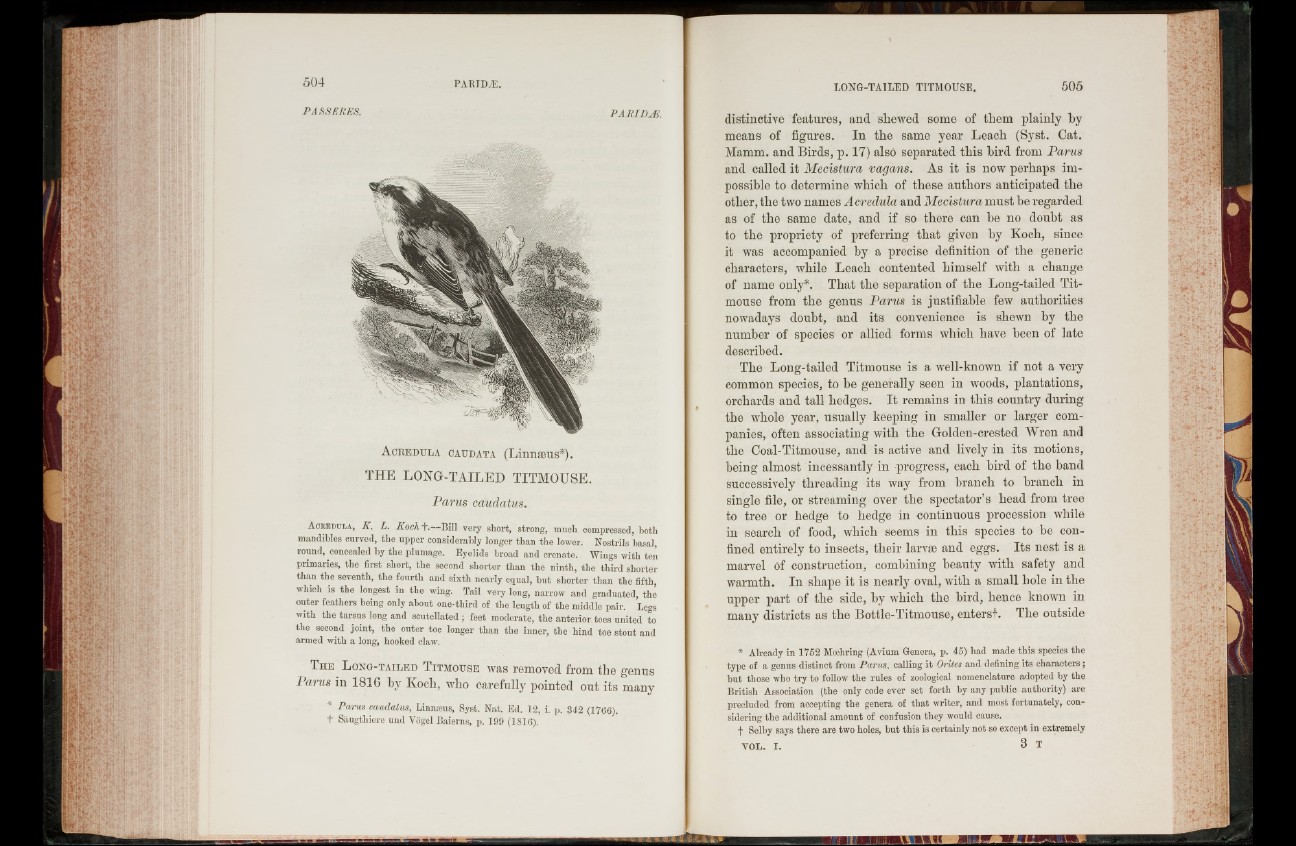
A c r ed u l a caudata (Linnasus*).
THE LONG-TAILED TITMOUSE.
Parus caudatus.
A c r ed u la , K. L. Kocli'f■—B il l very short, strong, much compressed, both
mandibles curved, the upper considerably longer than the lower. Nostrils basal,
round, concealed by the plumage. Eyelids broad and eremite. Wings with ten
primaries, the first short, the second shorter than the ninth, the third shorter
than the seventh, the fourth and sixth nearly equal, but shorter than the fifth,
which is the longest in the wing. Tail very long, narrow and graduated, the
outer feathers being only about one-third of the length of the middle pair. Legs
with the tarsus long and scutellated ; feet moderate, the anterior, toes united to
the second joint, the outer toe longer than the inner, the hind toe stout and
armed with a long, hooked claw.
T h e L o n g -t a il e d T itm o u s e was removed from the genus
Parus in 1816 by Koch, who carefully pointed out its many
Parus caudatus, Linmeus, Syst. Nat. Ed. 12, i. p. 312 (1766).
t Saugthiere und Vogel Baierns, p. 199 (1816).
distinctive features, and shewed some of them plainly by
means of figures. In the same year Leach (Syst. Cat.
Mamm. and Birds, p. 17) also separated this bird from Parus
and called it Mecistura vagans. As it is now perhaps impossible
to determine which of these authors anticipated the
other, the two names A credula and Mecistura must be regarded
as of the same date, and if so there can he no doubt as
to the propriety of preferring that given by Koch, since
it was accompanied by a precise definition of the generic
characters, while Leach contented himself with a change
of name only*. That the separation of the Long-tailed Titmouse
from the genus Parus is justifiable few authorities
nowadays doubt, and its convenience is shewn by the
number of species or allied forms which have been of late
described.
The Long-tailed Titmouse is a well-known if not a very
common species, to he generally seen in woods, plantations,
orchards and tall hedges. I t remains in this country during
the whole year, usually keeping in smaller or larger companies,
often associating with the Golden-crested Wren and
the Coal-Titmouse, and is active and lively in its motions,
being almost incessantly in progress, each bird of the hand
successively threading its way from branch to branch in
single file, or streaming over the spectator’s head from tree
to tree or hedge to hedge in continuous procession while
in search of food, which seems in this species to be confined
entirely to insects, their larvae and eggs. Its nest is a
marvel of construction, combining beauty with safety and
warmth. In shape it is nearly oval, with a small hole in the
upper part of the side, by which the bird, hence known in
many districts as the Bottle-Titmouse, enters!. The outside
* Already in 1752 Moehring (Avium Genera, p. 45) had made this species the
type of a genus distinct from Parus, calling it Orites and defining its characters;
hut those who try to follow the rules of zoological nomenclature adopted by the
British Association (the only code ever set forth by any public authority) are
precluded from accepting the genera of that writer, and most fortunately, con-
sidering the additional amount of confusion they would cause.
f Selby says there are two holes, but this is certainly not so except in extremely
VOL. I . 3 T